Andhra Pradesh BIEAP AP Inter 1st Year Economics Study Material 2nd Lesson Theory of Consumers Behaviour Textbook Questions and Answers.
AP Inter 1st Year Economics Study Material 2nd Lesson Theory of Consumers Behaviour
Essay Questions
Question 1.
Explain the law of diminishing marginal utility and its limitations. [March 17]
Answer:
Hermann Heinrich Gossen was the first economist to explain the law of diminishing marginal utility in 1854. It is also known as Gossen’s ‘first law’. In 1890 Marshall in his principles of economics developed and popularised this analysis. This law explains the functional relationship between the stock of commodity and the marginal utility of the commodity.
According to Marshall “The additional benefit which a person derives from a given increase of his stock thing diminishes with every increase in the stock that he already has”.
“A consumer increases the consumption of any one commodity keeping constant the consumption of all other commodities the marginal utility of the variable commodity must eventually decline”. Kenneth E.Boulding.
The law says that as we gone consuming a commodity satisfaction derives from its additional units goes on diminishes.
Assumptions :
- Rationality : Consumer is a rational man which means he always tries to get maximum satisfaction.
- Cardinal measurement of utility : Utility is a cardinal concept, i.e., utility can be measured and compared numerically.
- Utilities are independent: It implies that utility of any commodity depends as its own quantity
- Homogeneous : Units of the commodity are similar in quantity, size, taste and colour etc.
- No time gap : There should not be any time gap between the consumption of one unit and other it.
- Constant marginal utility : It is assumed that the marginal utility of money remains constant. ’
- Total & marginal utility : Total utility : Total satisfaction obtained by the consumer from the consumption of a given quantity of commodity.
TUn = f(Qn)
Where TUn = Total utility of n commodity,
f = functional relationship,
Qn = Quantity of n commodity.
Marginal utility: Marginal utility is the addition made to the total utility by consuming one more unit of the commodity.
It can be explained as
MUn = TUn – TUn-1
MUn = Marginal utility of nth unit
TUn = Total utility of nth unit
TUn-1 = Total utility of n – 1 units.
MU may also be expressed as follows.
Marginal utility is the additional utility derived from the consumption of an extra unit of commodity.
MU = \(\frac{\Delta \mathrm{TU}}{\Delta \mathrm{C}}\)
Where ∆TU = Change in total utility
∆C = Change in no. of units consumed.
Explanation of the law : The law of diminishing marginal utility explains the relation between the quantity of good and its marginal utility. If a person goes on increasing his stock of a thing, the marginal utility derived from an additional unit declines. We show this tendency with an imaginary table given below.
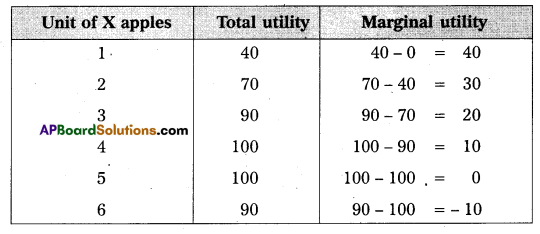
In the table let us suppose that one is fond of apples. As he consumes one apple after another he derives less and less satisfaction. The first unit consumed with atmost pleasure. For the second, the intensity of his desire diminishes. The third will be still less and so on. The total utility increasing until the consumption of fourth unit of good but diminishing rate. Fifth unit of apple gives him maximum total utility. But marginal utility becomes zero. Further consumption of sixth unit TU diminishes and MU becomes negative.
The relationship between total utility and marginal utility is explained in the following three ways.
- When total utility increases at diminishing rate, marginal utility falls.
- When total utility is maximum, marginal utility becomes zero.
- When total utility decreases, marginal utility becomes negative.
This can be shown in the following diagram.

In the diagram on ‘X’ axis measures units of apples and OY axis measures total utility and marginal utility. TU curve represents total utility and MU curve represents marginal utility. TU curve is maximum at 5th unit where MU curve will become zero. TU curve slopes downwards from 6th unit, while MU will become negative.
Limitations or Exceptions :
- Hobbies: This law does not operate in the case of hobbies like collection of stamps, old paintings, coins etc. Greater the collections of a person, greater is his satisfaction. Marginal utility will not diminish.
- Drunkers : It is pointed out that the consumption of liquor is not subject to the law of diminishing marginal utility. The more a person drinks liquor, the more he likes it.
- Miser : This law does not apply to money. The more money a person has the greater is the desire to acquire still more of it.
- Further, this law does not hold good if any change in income of the consumer, tastes and preferences.
![]()
Question 2.
Critically examine the law of equi-marginal utility.
Answer:
Law of equi – marginal utility is an important law of consumption. It is called as “Gossen’s second law”, as its formulations is associated with the name of H.H.Gossen.
According to Marshall “If person has a thing which can be put to several uses, he will distribute it among these uses in such a way that it has the same marginal utility in all uses. If it had a greater marginal utility in one use than in another, he would gain by taking away some of it from the second and applying it to the first”.
According to this law the consumer has to distribute his money income on different uses in such a manner that the last rupee spent on each commodity gives him the same marginal utility. Equalisation of marginal utility in different uses will maximise his total satisfaction. Hence this law is known as the “Law of equi-marginal utility”.
The fundamental condition for consumer’s equilibrium can be explained in the following way.
\(\frac{\mathrm{MU}_{\mathrm{x}}}{\mathrm{P}_{\mathrm{x}}}=\frac{\mathrm{MU}_{\mathrm{y}}}{\mathrm{P}_{\mathrm{y}}}=\frac{\mathrm{MU}_{\mathrm{z}}}{\mathrm{P}_{\mathrm{z}}}\) = MUm
Where MUx, MUy, MUz, MUm = Marginal utilities of commodities x, y, z, m;
Px, py, pz = Prices of X, y, z.
This law can be explained with the help of a table. Suppose the consumer is prepared to spend his money income is ₹ 26/- on two goods X and Y. Market prices of two goods are ₹ 4/- & ₹ 5/- respectively. Now the marginal utilities of good x & good y are shown below.

For explaining consumer’s maximum satisfaction and consequent equilibrum position we need to reconstruct the above table by dividing marginal utilities of x by its price ₹ 4/- and marginal utility of y by ₹ 5/-. This is shown in the following table.

In the table it is clear that when consumer purchase 4 units of goods x & 2 units of good y. Therefore, consumer will.be in equilibrium when he is spending (4 × 4 = 16 + 2 × 5 = 10) ₹ 26 on them.
Limitations of the law : The law of equi marginal utility has been subject to certain limitations which are as given below.
- The law assumes that consumer is a rational man and always tries to get maximum satisfaction. But it is not possible always to compare the utilities derived from different commodities.
- This law not applicable when goods are indivisible.
- The law is based on unrealistic assumptions like cardinal measurement of utility and marginal utility of money remains constant. In real world MU of money does not remain constant.
- This law will not be applicable to complementary goods.
- Another limitations of this law is that there is no fixed accounting period for the consumer in which he can buy and consume goods.
![]()
Question 3.
Explain consumer’s equilibrium with law of equi-marginal utility. [March 18]
Answer:
Law of equi-marginal utility is an important law of consumption. It is called as “Gossen’s with the name of H.H.Gossen. According to Marshall “If person has a thing which can be put to several uses, he will distribute it among these uses in such a way that it has the same marginal utility in all uses. If it had a greater marginal utility in one use than in another, he would gain by taking away some of it from the second and applying it to the first”.
According to this law the consumer has to distribute his money income on different uses in such a manner that the last rupee spent on each commodity gives him the same marginal utility. Equalisation of marginal utility in different uses will maximise his total satisfaction. Hence this law is known as “law of equi-marginal utility”.
Assumptions of the law : The law of equi-marginal utility depends on the following assumptions.
- This law is based on cardinal measurement of utility.
- Consumer is a national man always aiming at maximum satisfaction.
- The marginal utility of money remains constant.
- Consumer’s income is limited and he is proposed to spent the entire amount on different goods.
- The price of goods are unchanged.
- Utility derived from one commodity is independent of the utility of the other commodity.
The fundamental condition for consumer’s equilibrium can be explained in the following way.
\(\frac{\mathrm{MU}_{\mathrm{x}}}{\mathrm{P}_{\mathrm{x}}}=\frac{\mathrm{MU}_{\mathrm{y}}}{\mathrm{P}_{\mathrm{y}}}=\frac{\mathrm{MU}_{\mathrm{z}}}{\mathrm{P}_{\mathrm{z}}}\) = MUm
Where MUx, MUy, MUx, MUm = marginal utility of commodities X, Y, Z, m;
Px, Py, Pz = prices of x, y, z.
This law can be explained with the help of a table. Suppose the consumer is prepared to spend his money income is ₹ 26/- on two goods x and y. Market prices of two goods are ₹ 4/- & ₹ 5/- respectively. Now the marginal utilities of goods x & y are shown below.
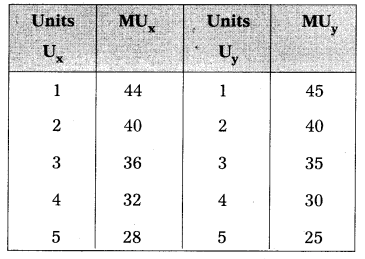
For explaining consumer’s maximum satisfaction and consequent equilibrum position we need to reconstruct the above table by dividing marginal utilities of x its price ₹ 4/- and marginal utility of y by ₹ 5/-. This is shown in the following table.
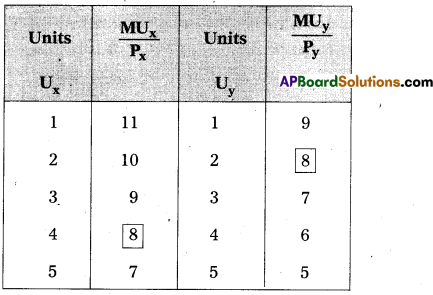
In the table it is clear that when consumer purchase 4 units of goods x & 2 units of good y. Therefore, consumer will be in equilibrium when he is spending (4 × 4 = 16 + 2 × 5 = 10) ₹ 26 on them.
Consumer’s equilibrium may be shown in the diagram.
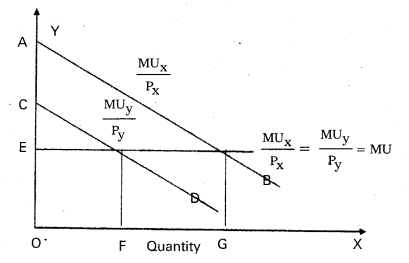
Consumer’s equilibrium by using principle of equi-marginal utility
In the diagram marginal utility curves of goods slope downwards i.e. AB & CD taking of the income of the consumer as given, suppose his M>U of money constant at OE. \(\frac{\mathrm{MU}_{\mathrm{x}}}{\mathrm{P}_{\mathrm{x}}}\) is equal to OE when OG quantity of good X is brought. \(\frac{\mathrm{MU}_{\mathrm{y}}}{\mathrm{P}_{\mathrm{y}}}\) is equal to OE, when OF quantity of good y is purchased. Thus consumer purchasing OG of X and OF of Y. \(\frac{\mathrm{MU}_{\mathrm{x}}}{\mathrm{P}_{\mathrm{x}}}=\frac{\mathrm{MU}_{\mathrm{y}}}{\mathrm{P}_{\mathrm{y}}}\) = MUm. This is consumer’s equilibrium.
![]()
Question 4.
Explain the consumer’s equilibrium using indifference curve.
Answer:
The point where the consumer gets maximum possible satisfaction, where the budget line is tangent to the indifference curve and the MRS is equal to the price ratio of the two goods will be defined as equilibrium of the consumer.
Assumptions :
- Consumer scale of preferences must remain constant.
- Money income of thfe consumer must remain constant.
- The price of two goods must remain unchanged.
- There should be no change in the tastes and habits of the consumer.
- The consumer is rational and thus maximises his satisfaction.
Conditions of equilibrium : There are two conditions that must be satisifed for the consumer to be in equilibrium. They are :
- At the point of equilibrium, the budget / price line must be tangent to the indifference curve.
- At the point of equilibrium, the consumer’s MRSxy and the price ratio must be equal.
i.e„ MRSxy = \(\frac{P_x}{P_y}\)
This can be shown in the following diagram.
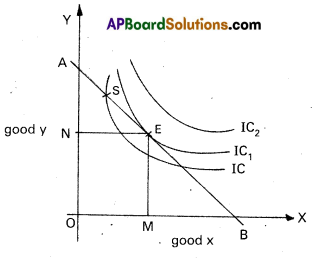
In the diagram ‘AB’ is consumer’s budget or price line. IC, IC1, IC2 are indifference curves. In the diagram the consumer is equilibrium OM of x and ON of y. At point E the price line touches to an IC1. At point ‘S’ consumer will be on ‘O’ lower indifference curve IC and will be getting less satisfaction than at E on IC. IC2 is beyond the capacity of consumer. So it is outside to the budget line.
Question 5.
Define price line / budget line and explain shifts in the budget line.
Answer:
The budget line or price line shows all possible combinations of two goods that a consumer can buy with the given income of the consumer and prices of the two goods.
The concept of budget / price line will be shown in the following example. Suppose that a consumer has ₹ 150 (income) to buy two goods namely X and Y. Whose prices are ₹ 15 and ₹ 30 each. With the given information now we can draw the budget or price line as shown in the diagram.

In the above diagram ‘AB’ is the ‘budget or price line’. The slope of the line AB represents the ratio of the prices of X and Y in such a manner that 10 of x will be equal to 5 of y.
Shifts in the Budget line : The position of the budget line depends upon size of money income of the consumer. If his income increase and the price of the two commodities remaining the same, the consumer can buy more of both the commodities. On the other hand, if his income decreases, the prices of the two commodities remaining the same the consumer now to reduce his purchase. As a result of changes in the consumer income, there will be shifts in budget line also. The same is shown in the following diagram.

- When the income of the consumer increase, the budget line moves towards right from the original to AB to A’B’.
- When the income of the consumer decrease, the budget line moves to the left from the original / initial AB to A”B”.
Change in price line : The slope of the price line depends on the prices of both the commodities there will be a change in the slope of the price line when there is a change in the price or either of the two commodities.
i) Suppose that the price of ‘X’ falls, while the price of Y and money income of the consumer remaining the same.
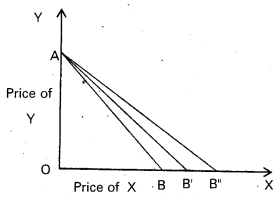
In the above diagram, the initial price line of AB, before change in the price of X’. Suppose that the price of X’ has fallen and the price of ‘Y’ remaining the same.
![]()
ii) Suppose that the price Y falls, while the price of X and money income of the consumer re-maining the same.
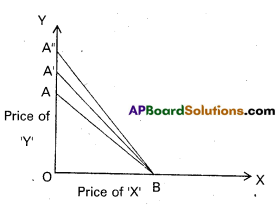
In the above diagram, the initial line is AB that is before a change in price of Y.
Short Answer Questions
Question 1.
Difference between cardinal and ordinal utility.
Answer:
The concept of utility was introduce by Benham in 1789. Utility means want satisfying power of a commodity. It is a psychological phenomenon. The measurement of utility, there are two different approaches.
- Cardinal utility
- Ordinal utility
1) Cardinal utility : This approach was developed by Alfred Marshall. According to him utility is psychological concept. So it can be measured ‘util’. The numbers 1, 2, 3, 4 etc are cardinal numbers. According to this analysis the utilities derived from consumption of different commodities can be measured in terms of arbitary units, such as 1, 2, 3 … and so on.
2) Ordinal utility : This approach was developed by R.J.D. Allen and J.R.Hicks. According to them utility is psychological concept. So we cannot measure in numerically much less compared. The numbers 1st, 2nd, 3rd, 4th etc., are ordinal numbers. The ordinal numbers are ranked. It means the utilities obtained by the consumer from different goods can be arranged in a serial order such as 1st, 2nd, 3rd, 4th etc.
Question 2.
Properties of IC (Indifference curves). [March 18, 17, 16]
Answer:
The important properties of indifference curves are :
- Indifference curves slopes downwards from left to right there exists negative slope.
- Indifference curves are convex to the origin because of diminishing marginal rate of substitution.
- Indifference curves can never intersect each other.
- Higher indifference curve represent higher level of satisfaction. Indifference curve to the right represents higher satisfaction.
![]()
Question 3.
Marginal Rate of Substitution
Answer:
The concept of MRS (Marginal Rate of Substitution) is the basis of indifference curves. The MRS may be defined as the rate at which an individual will exchange successive unity of one commodity for another. This can be explained with the help of following example.

From the table it is clear that consumer has 15 units of good Y and 1 of good X, he is willing to forego 4Y for IX. Here marginal rate of substitution of X for Y is 4 :1 and for 3rd combination it is 3 : 1 and so on. The MRS xy diminishes as the consumer goes on substituting X for Y.
MRSxy = \(\frac{\Delta Y}{\Delta X}\)
Question 4.
Indifference Map
Answer:
A set of indifference curves drawn for different income levels is called as “indifference map”. In other words indifference map is the locus of various indifference curves various levels of satisfaction to the consumer.
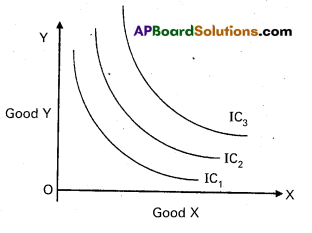
From the above diagram it is clear that an indifference map of IC1, IC2, IC2. Each curve shows a certain level of satisfaction to the consumer: The different indifference curves are always arranged and numbered in ascending order.
As are moves from IC1 to IC3 on an indifference map, the IC labelled higher number (IC3) is preferred to the IC labelled lower number (IC1).
![]()
Question 5.
Price Line.
Answer:
The budget / price line shows all possible combinations of two goods that a consumer can buy, with given income of the consumer and prices of the two goods. But which particular combination of two goods on IC he can get depends on two factors.
- Consumer’s money income
- Prices of two goods.
The concept of budget / price line will be shown in the following diagram.
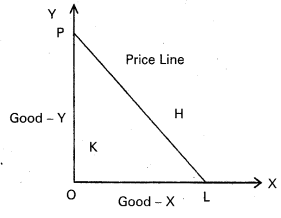
In the above diagram PL is Budget line. If consumer spend his total income on good X, he could get L. Any point outside the given price line H will beyond the capacity of consumer, K is under spending Capacity.
The concept of price line or budget line can be known the following example. Suppose the consumer has ₹ 5/- to buy two goods say X and Y prices of X and Y are ₹ 1/- and 0.50 paisa. Then the following are the opportunities available before him.

- If consumer spends his total amount of ₹ 5 on X only he gets 5 units of X and none of Y.
- If he spends whole of his money i.e., ₹ 5 on Y only he gets 10 units of Y and none of X.
- If consumer wants to have both X & Y. Therefore he can move within OAB of price line.
Additional Questions
Question 6.
Explain the importance of law of equi-marginal utility.
Answer:
The law of equi-marginal utility states that a consumer will be in equilibrium when the marginal utility of the various commodity are equal.
Importance :
- Basis of consumer expenditure : It is basis for consumers expenditure and guide the consumers while allocating resources.
- In the field of production : This law is useful to the producer and it explains how a producer maximises his profits and reduces cost of production.
- Exchange : In all our exchanges, this law works, for exchange is nothing but substitution of one thing for another.
- Public Finance : This law helps the government in the allocation of scarce resources and also the government levied taxes on the basis of this principle.
- Price determination : This principle has an important bearing on the determination of value.
![]()
Question 7.
Explain superiority of the indifference curve technique.
Answer:
- It is an analysis of multi-goods model.
- It does not assume marginal utility of money remains constant.
- It analyses income effect, price effect and substitution effect.
- The assumption of ordinal measurement of utility made by indifference curve is less restrictive and more realistic.
Question 8.
What are the important assumptions of indifference techniques ?
Answer:
An indifference curve represents satisfaction of a consumer from two commodities. An IC curve can defined as the locus of points each representing a different combination of two goods yielding the same level of satisfaction.
Assumptions :
- Rationality: It is assumed that the consumer tries to obtain maximum satisfaction from his expenditure.
- Scale of preference : Consumer is able to arrange the available combinations of goods according to scale of preference.
- Ordinal utility : It assumes ordinal utility approach. So utility measurable only ordinal terms i.e., 1st, 2nd, 3rd ………… etc.
- Diminishing marginal rate of substitution : It is the rate at which a consumer is willing to substitute commodity to another. So that this satisfaction remains the same.
- Consistency : Consumer’s choices have to consistent. It means if consumer prefers A to B and B to C his choice reflects his rationality.
- Completeness : The consumer’s scale of preferences is to complete that he is able to choose any one of the two combinations of commodities presented to him.
Very Short Answer Questions
Question 1.
Utility
Answer:
The want satisfying power or capacity of a commodity or service is known as utility. It is the basis of consumer’s demand for a commodity.
![]()
Question 2.
Cardinal utility [March 17]
Answer:
Alfred Marshall developed cardinal utility analysis. According to this analysis the utilities derived from consumption of different commodities can be measured in terms of arbitary units called utils. 1, 2, 3, 4 are called cardinal numbers.
Question 3.
Ordinal utility
Answer:
This was developed by J.R.Hicks, Allen. Utility is subjective and measurement of utility in numerical terms is not possible. We can observe the preference one for a good more than for another. Ordinal numbers such as 1st, 2nd, 3rd ………….. etc. The ordinal numbers are ranked.
Question 4.
Scale of preferences
Answer:
Guides the consumer in his purchases. It reflects his tastes and preferences.
Question 5.
Price Line [March 16]
Answer:
It shows all possible combinations of two goods that a consumer can buy, with the given income of the consumer’s and prices of the two goods.
Question 6.
MRS
Answer:
The additional amount of one product required to compensate a consumer for a small decrease in the quantity of another, per unit of the decrease.
Additional Questions
Question 7.
Total utility
Answer:
Total utility is the total amount of utility which a consumer derives from a given stock of a commodity.
TUn = f(Qn)
![]()
Question 8.
Marginal utility
Answer:
Marginal utility is the additional utility obtained from the consumption of additional unit of the commodity.
MUn = TUn – TU(n-1)
(or)
MU = \(\frac{\Delta \mathrm{TU}}{\Delta \mathrm{Q}}\)
Question 9.
Consumers equilibrium
Answer:
The term equilibrium implies a position of rest or changelessness. A consumer attains equilibrium only when he secures maximum satisfaction out of his expenditure. In distributing a commodity various uses, the consumer will secure maximum satisfaction if the marginal utility of the commodity equalised in all its uses.
\(\frac{\mathrm{MU}_{\mathrm{x}}}{\mathrm{P}_{\mathrm{x}}}=\frac{\mathrm{MU}_{\mathrm{y}}}{\mathrm{P}_{\mathrm{y}}}\) ………… and ao on.
Question 10.
Indifference curve
Answer:
It represents the satisfaction of a consumer from two goods of various combinations. It is drawn on the assumption that for all possible combinations of the two goods on an indifference curve, the satisfaction level remains the same.
Question 11.
Iso-utility curve
Answer:
Iso-utility curve is also known as indifference curve or the curve of equal utility. The situation where consumers yield the same level of total satisfaction at various combinations of the commodities called Iso-utility curve.
![]()
Question 12.
Indifference schedule
Answer:
It is a table representing the various combinations of goods which give equal satisfaction to the consumer. An indifference curve is drawn on the basis of an “indifference schedule”.
Question 13.
Indifference map
Answer:
A set of indifference curves drawn for different income levels is called indifference map.

From the above diagram it is clear that an indifference map of IC1, IC2, IC3. Each curve shows a certain level of satisfaction to the consumer.